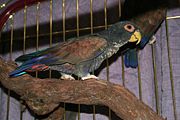
Bronze-winged Parrot
Encyclopedia
The Bronze-winged Parrot (Pionus chalcopterus) is a medium sized pionus
parrot 28 cm (11 in) long. It is a short-tailed stocky parrot
found in forest and woodland in north-western South America
.
, but some continue to recognize two subspecies
:
 The Bronze-winged Parrot is found in far western Venezuela, western and central Colombia, western Ecuador and far north-western Peru. In Venezuela it mainly occurs at altitudes of 900–1400 m, in Colombia it mainly occurs at altitudes of 1400–2400 m (occasionally as high as 2800 m), in Ecuador mainly below 1400 m, and in Peru below 800 m. It generally prefers the canopy of forest and woodland (both humid and semi-deciduous
The Bronze-winged Parrot is found in far western Venezuela, western and central Colombia, western Ecuador and far north-western Peru. In Venezuela it mainly occurs at altitudes of 900–1400 m, in Colombia it mainly occurs at altitudes of 1400–2400 m (occasionally as high as 2800 m), in Ecuador mainly below 1400 m, and in Peru below 800 m. It generally prefers the canopy of forest and woodland (both humid and semi-deciduous
), but also occurs in adjacent habitats with tall trees. It appears to be rather nomadic in parts of its range, but the movements (possibly only in response to the availability of food) are generally poorly understood.
The Bronze-winged Parrot nests in tree cavities. The eggs are white and there are usually three to four in a clutch. The female incubates the eggs for about 26 days and the chicks leave the nest about 70 days after hatching.
Pionus
Pionus is a genus of medium-sized parrots native to Mexico, and Central and South America. Characteristic of the genus are the chunky body, bare eye ring , and short square tail. They are superficially similar to Amazon parrots, but smaller and in flight their wing-strokes are far deeper...
parrot 28 cm (11 in) long. It is a short-tailed stocky parrot
Parrot
Parrots, also known as psittacines , are birds of the roughly 372 species in 86 genera that make up the order Psittaciformes, found in most tropical and subtropical regions. The order is subdivided into three families: the Psittacidae , the Cacatuidae and the Strigopidae...
found in forest and woodland in north-western South America
South America
South America is a continent situated in the Western Hemisphere, mostly in the Southern Hemisphere, with a relatively small portion in the Northern Hemisphere. The continent is also considered a subcontinent of the Americas. It is bordered on the west by the Pacific Ocean and on the north and east...
.
Description
It is mainly dark with a whitish chin patch and its upper chest is speckled with pink feathers. It has short red undertail feathers. The rump, tail and wings are dark blue with lighter blue underwings. The head is dark blue-green; the mantle, back and underparts are dark bronze-green with some blue tipped feathers and sometimes scattered red feathers. Its beak is pale yellow. In adults the ring of bare skin around the eyes is pink. Juveniles have whitish eyerings and their underparts are brownish.Taxonomy
Today most authorities consider this species as monotypicMonotypic
In biology, a monotypic taxon is a taxonomic group with only one biological type. The term's usage differs slightly between botany and zoology. The term monotypic has a separate use in conservation biology, monotypic habitat, regarding species habitat conversion eliminating biodiversity and...
, but some continue to recognize two subspecies
Subspecies
Subspecies in biological classification, is either a taxonomic rank subordinate to species, ora taxonomic unit in that rank . A subspecies cannot be recognized in isolation: a species will either be recognized as having no subspecies at all or two or more, never just one...
:
- P. c. chalcopterus: west Venezula, and north and central ColombiaColombiaColombia, officially the Republic of Colombia , is a unitary constitutional republic comprising thirty-two departments. The country is located in northwestern South America, bordered to the east by Venezuela and Brazil; to the south by Ecuador and Peru; to the north by the Caribbean Sea; to the...
. - P. b. cyanescens: south-west Colombia, west EcuadorEcuadorEcuador , officially the Republic of Ecuador is a representative democratic republic in South America, bordered by Colombia on the north, Peru on the east and south, and by the Pacific Ocean to the west. It is one of only two countries in South America, along with Chile, that do not have a border...
, and north-west PeruPeruPeru , officially the Republic of Peru , is a country in western South America. It is bordered on the north by Ecuador and Colombia, on the east by Brazil, on the southeast by Bolivia, on the south by Chile, and on the west by the Pacific Ocean....
. Reputedly with broader blue margins on feathers, chin patch and surrounding ring smaller and less distinct.
Range and habitat

Deciduous
Deciduous means "falling off at maturity" or "tending to fall off", and is typically used in reference to trees or shrubs that lose their leaves seasonally, and to the shedding of other plant structures such as petals after flowering or fruit when ripe...
), but also occurs in adjacent habitats with tall trees. It appears to be rather nomadic in parts of its range, but the movements (possibly only in response to the availability of food) are generally poorly understood.
Behavior
It is typically seen in pairs of small groups of up to ten birds.The Bronze-winged Parrot nests in tree cavities. The eggs are white and there are usually three to four in a clutch. The female incubates the eggs for about 26 days and the chicks leave the nest about 70 days after hatching.

